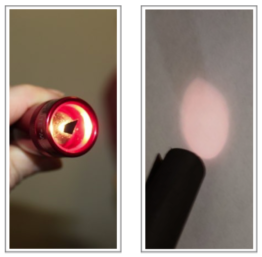Day One
The lights off at the start of this episode. Jessica and Jordan shine their flashlights on the floor. Jessica’s flashlight has a short black tube wrapped around it; Jordan’s has a long tube. They notice a large spot on the floor from Jessica’s and a small spot from Jordan’s.
Amanda suggests the fuzzy edges are from the “seconds”—the light that bounces off the side of the tube before leaving the flashlight. Dee challenges Amanda’s idea: Why are the seconds only visible along the edges? The entire spot should be fuzzy.
Amanda puts a piece of black tape in the center of the flashlight (left) to block the straight rays that leave the tube without hitting it, which should isolate the seconds. With little class time left, Amanda tests her set-up and the results confirm her prediction (right).

Day 2
Planning for Day 2, the instructors wanted other students in the class to recreate Amanda’s reasoning. They developed a worksheet to use in class, which asks students first to model how light rays create a fuzzy edge, and then to use their model to predict what would happen with a piece of tape placed in the center of the flashlight.
Students worked individually and then in groups, sketching consensus models on whiteboards. Groups presented their models to the class. At a lull in the conversation, Leslie addresses one group, saying:
At this point there are two open questions for the class: (1) should they differentiate between “seconds” and “thirds,” and (2) if light “bounces on the mirror and then straight out, is it a first or a second?”
Amanda and Dee wonder whether it’s worth keeping track of all the bounces, and suggest using Steven’s terms “primary and secondary” light. Then Amanda notices she drew light rays as “seconds” before they bounce (shown below, blue for “firsts” and black for “seconds”), whereas Allie’s group drew light rays becoming “seconds” at the first bounce.

Courtney returns to the question of whether a light ray becomes a “second” when it bounces off the mirror. Some of the students didn’t address the mirror in their drawings, because they had removed the mirrors from their flashlights in earlier experiments. Dee proposes that the important issue is determining whether light is completely reflected off the mirror or whether some of it gets absorbed.